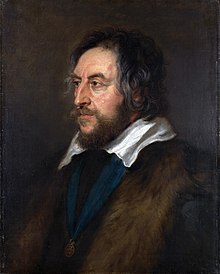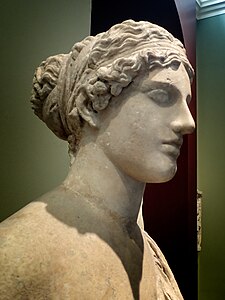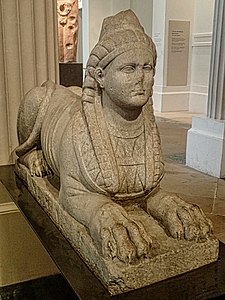
The British Museum is a public museum dedicated to human history, art and culture located in the Bloomsbury area of London. Its permanent collection of eight million works is the largest in the world. It documents the story of human culture from its beginnings to the present. The British Museum was the first public national museum to cover all fields of knowledge.
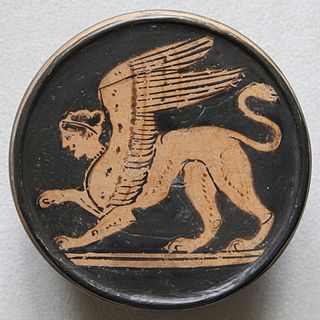
A sphinx is a mythical creature with the head of a human, the body of a lion, and the wings of an eagle.

The Ashmolean Museum of Art and Archaeology on Beaumont Street, Oxford, England, is Britain's first public museum. Its first building was erected in 1678–1683 to house the cabinet of curiosities that Elias Ashmole gave to the University of Oxford in 1677. It is also the world's second university museum, after the establishment of the Kunstmuseum Basel in 1661 by the University of Basel.

Thomas Howard, 14th Earl of Arundel KG, was an English peer, diplomat and courtier during the reigns of King James I and King Charles I, but he made his name as a Grand Tourist and art collector rather than as a politician. When he died he possessed 700 paintings, along with large collections of sculptures, books, prints, drawings, and antique jewellery. Most of his collection of marble carvings, known as the Arundel marbles, was eventually left to the University of Oxford.
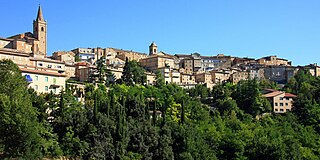
Falerone is a town and comune in the province of Fermo, in the Italian region of the Marche, southeast of Urbisaglia.
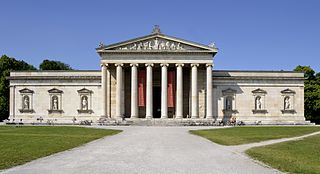
The Glyptothek is a museum in Munich, Germany, which was commissioned by the Bavarian King Ludwig I to house his collection of Greek and Roman sculptures. It was designed by Leo von Klenze in the neoclassical style, and built from 1816 to 1830. Today the museum is a part of the Kunstareal.

The Discobolus by Myron is an ancient Greek sculpture completed at the start of the Classical period in around 460–450 BC that depicts an ancient Greek athlete throwing a discus. Its Greek original in bronze lost, the work is known through numerous Roman copies, both full-scale ones in marble, which is cheaper than bronze, such as the Palombara Discobolus, the first to be recovered, and smaller scaled versions in bronze.

The Parian Chronicle or Parian Marble is a Greek chronology, covering the years from 1582 BC to 299 BC, inscribed on a stele. Found on the island of Paros in two sections, and sold in Smyrna in the early 17th century to an agent for Thomas Howard, Earl of Arundel, this inscription was deciphered by John Selden and published among the Arundel Marbles, Marmora Arundelliana nos. 1–14, 59–119. The first of the sections published by Selden has subsequently disappeared. A further third fragment of this inscription, comprising the base of the stele and containing the end of the text, was found on Paros in 1897. It has entries from 336/35 to 299/98 BC.

The Capitoline Museums are a group of art and archaeological museums in Piazza del Campidoglio, on top of the Capitoline Hill in Rome, Italy. The historic seats of the museums are Palazzo dei Conservatori and Palazzo Nuovo, facing on the central trapezoidal piazza in a plan conceived by Michelangelo in 1536 and executed over a period of more than 400 years.

The Ludovisi Ares is an Antonine Roman marble sculpture of Mars, a fine 2nd-century copy of a late 4th-century BCE Greek original, associated with Scopas or Lysippus: thus the Roman god of war receives his Greek name, Ares.

Classical sculpture refers generally to sculpture from Ancient Greece and Ancient Rome, as well as the Hellenized and Romanized civilizations under their rule or influence, from about 500 BC to around 200 AD. It may also refer more precisely a period within Ancient Greek sculpture from around 500 BC to the onset of the Hellenistic style around 323 BC, in this case usually given a capital "C". The term "classical" is also widely used for a stylistic tendency in later sculpture, not restricted to works in a Neoclassical or classical style.

The study of Roman sculpture is complicated by its relation to Greek sculpture. Many examples of even the most famous Greek sculptures, such as the Apollo Belvedere and Barberini Faun, are known only from Roman Imperial or Hellenistic "copies". At one time, this imitation was taken by art historians as indicating a narrowness of the Roman artistic imagination, but, in the late 20th century, Roman art began to be reevaluated on its own terms: some impressions of the nature of Greek sculpture may in fact be based on Roman artistry.

The Belvedere Torso is a 1.59 m (5.2 ft) tall fragmentary marble statue of a male nude, known to be in Rome from the 1430s, and signed prominently on the front of the base by "Apollonios, son of Nestor, Athenian", who is unmentioned in ancient literature. It is now in the Museo Pio-Clementino of the Vatican Museums.

The Crouching Venus is a Hellenistic model of Venus surprised at her bath. Venus crouches with her right knee close to the ground, turns her head to the right and, in most versions, reaches her right arm over to her left shoulder to cover her breasts. To judge by the number of copies that have been excavated on Roman sites in Italy and France, this variant on Venus seems to have been popular.
The decade of the 1660s in archaeology involved some significant events.

The Archaeological Museum of Delos is a museum on the island of Delos, near Mykonos in the South Aegean, Greece. It is noted for its extensive collection of statues unearthed in the surrounding area of the ancient site, which has been declared a UNESCO World Heritage Site. Although the museum has a considerable collection, it does not contain all of the items found in Delos: a large quantity are on display in Athens at the National Archaeological Museum.

Iberian sculpture, a subset of Iberian art, describes the various sculptural styles developed by the Iberians from the Bronze Age up to the Roman conquest. For this reason it is sometimes described as Pre-Roman Iberian sculpture.

The marble Gaddi Torso displayed in the Classical Sculpture Room of the Uffizi, Florence, is a Hellenistic sculpture of the 2nd century BCE.

The Bust of Cleopatra VII is a granite bust currently on display in the Gallery of Ancient Egypt at the Royal Ontario Museum (ROM). It is believed to have been discovered in Alexandria, Egypt at the site of Cleopatra's sunken palace on the island of Antirhodos. The bust was purchased by the ROM's founder Charles Trick Currelly while on expedition in Egypt in the early 20th Century.

The Archaeological Museum of Milos is a museum in Plaka on the island of Milos, in Greece. Its collections include exhibits dating from the late Neolithic to the Byzantine period. The unique is collection of ancient Cycladic art, especially numerous findings from Phylakopi on Milos, from early Bronze Age to the late Bronze Age. The best pieces from Phylakopi are in the Ashmolean Museum (Oxford), in the British Museum, and in the National Museum of Athens and elsewhere around the world.
